The Rise of BRICS from Developing Countries to Emerging Economies
29 Pages7490 Words27 Views
Added on 2021-06-14
The Rise of BRICS from Developing Countries to Emerging Economies
Added on 2021-06-14
ShareRelated Documents
Running head: BRICS
The BRICS (Brazil Russia India China and South Africa)
Name
Institution
The BRICS (Brazil Russia India China and South Africa)
Name
Institution
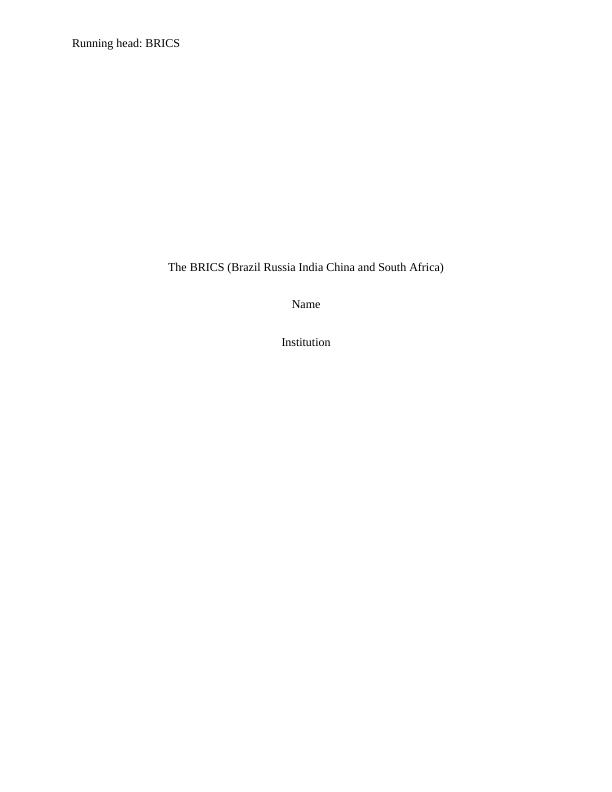
BRICS 2
Table of Contents
Introduction......................................................................................................................................3
Background Information..............................................................................................................3
Profile of BRICS member states..................................................................................................5
Brazil........................................................................................................................................5
Russia.......................................................................................................................................5
India..........................................................................................................................................6
China........................................................................................................................................6
South Africa.............................................................................................................................7
The Rise of BRICS from Developing Countries to Emerging Economies.....................................8
Accomplishments of BRICS..........................................................................................................10
Improved Trade..........................................................................................................................10
Increase in Foreign Direct Investment.......................................................................................11
Economic Growth and Development.........................................................................................12
Financial Stability......................................................................................................................13
Failures of BRICS..........................................................................................................................14
Failure to common form policy.................................................................................................14
Failure to Bring Unity................................................................................................................14
Table of Contents
Introduction......................................................................................................................................3
Background Information..............................................................................................................3
Profile of BRICS member states..................................................................................................5
Brazil........................................................................................................................................5
Russia.......................................................................................................................................5
India..........................................................................................................................................6
China........................................................................................................................................6
South Africa.............................................................................................................................7
The Rise of BRICS from Developing Countries to Emerging Economies.....................................8
Accomplishments of BRICS..........................................................................................................10
Improved Trade..........................................................................................................................10
Increase in Foreign Direct Investment.......................................................................................11
Economic Growth and Development.........................................................................................12
Financial Stability......................................................................................................................13
Failures of BRICS..........................................................................................................................14
Failure to common form policy.................................................................................................14
Failure to Bring Unity................................................................................................................14
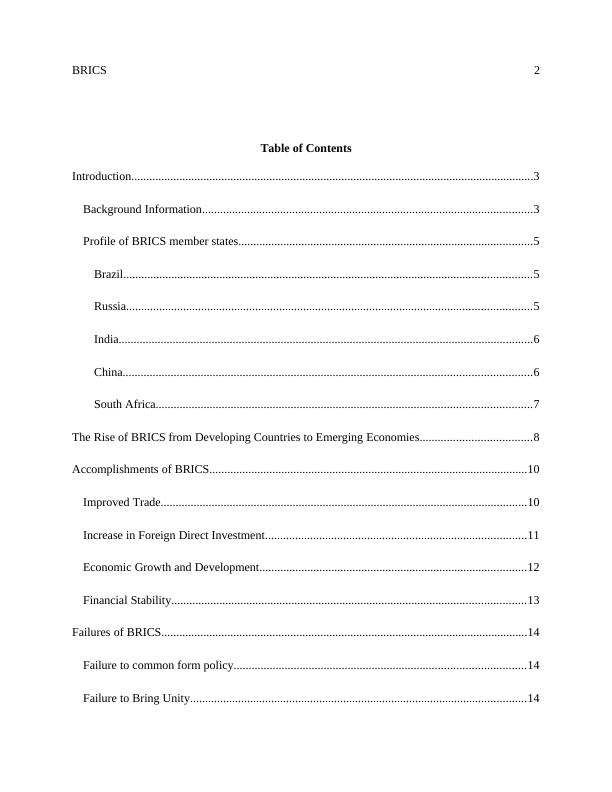
BRICS 3
Failure to have a Common Growth Rate...................................................................................15
Relevancy of the Group.................................................................................................................15
Challenges that BRICS Must Overcome to Remain Relevant......................................................15
Conclusion.....................................................................................................................................20
References......................................................................................................................................22
Failure to have a Common Growth Rate...................................................................................15
Relevancy of the Group.................................................................................................................15
Challenges that BRICS Must Overcome to Remain Relevant......................................................15
Conclusion.....................................................................................................................................20
References......................................................................................................................................22
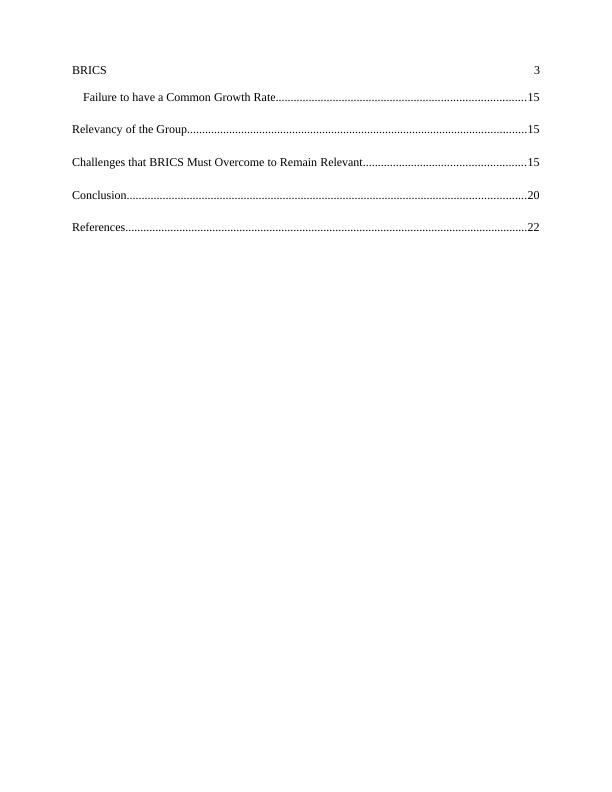
BRICS 4
Abstract
Brazil, Russia, India, China and South Africa are emerging economies who in the last
decade have emerged as a group seeking to change the structure of international development
politics. In the course of the last 10 years the five countries have increased their assistance
especially to the Low Income Countries; both financial and technical assistance. In so doing
BRICS have come up with unique methods of cooperation with the Low Income Countries. The
5 countries are determined to upset the traditional donors in Western countries particularly the
European Union (EU). The common features of BRICS include; their massive economies, high
economic growth rates and fair share of the global economy and their common push for a
recognition in the global governance and development. Even so, BRICS are sovereign states and
the member countries still retain their individual relationships with other countries. The
relationship of the BRICS with developing countries follows the order of the SSC (South-South
Cooperation). This mode of international cooperation is founded on a belief in shared
experiences, solidarity in action and the pursuit for reliance of the Southern states. Trade,
Foreign Direct Investment and development financing have characterized BRICS relationship
with Low Income Countries.
Introduction
Background Information
Brazil, Russia, India, China and South Africa (BRICS) are top developing economies and
political powers both at the regional and international levels. The acronym BRICS was initially
begat in 2001 to underscore the significance of 4 developing economies and at the time included
Abstract
Brazil, Russia, India, China and South Africa are emerging economies who in the last
decade have emerged as a group seeking to change the structure of international development
politics. In the course of the last 10 years the five countries have increased their assistance
especially to the Low Income Countries; both financial and technical assistance. In so doing
BRICS have come up with unique methods of cooperation with the Low Income Countries. The
5 countries are determined to upset the traditional donors in Western countries particularly the
European Union (EU). The common features of BRICS include; their massive economies, high
economic growth rates and fair share of the global economy and their common push for a
recognition in the global governance and development. Even so, BRICS are sovereign states and
the member countries still retain their individual relationships with other countries. The
relationship of the BRICS with developing countries follows the order of the SSC (South-South
Cooperation). This mode of international cooperation is founded on a belief in shared
experiences, solidarity in action and the pursuit for reliance of the Southern states. Trade,
Foreign Direct Investment and development financing have characterized BRICS relationship
with Low Income Countries.
Introduction
Background Information
Brazil, Russia, India, China and South Africa (BRICS) are top developing economies and
political powers both at the regional and international levels. The acronym BRICS was initially
begat in 2001 to underscore the significance of 4 developing economies and at the time included
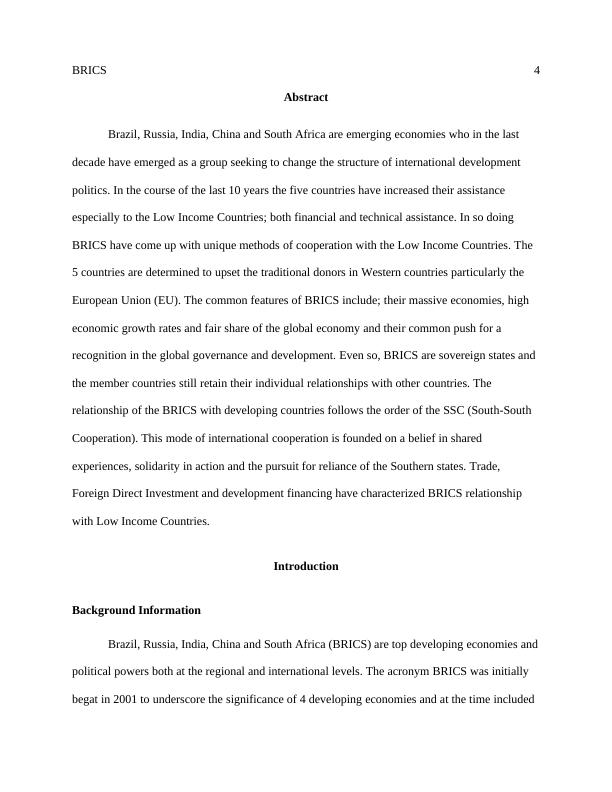
BRICS 5
only Brazil, Russia, India and China (BRIC). It was held then that the high growth rate of their
economies, economic strength and demographics (massive population) would put BRIC in a
position of advantage and it was contended that their expanded significance ought to likewise be
reflected in their joining to the G7 (De Almeida 2011). The four nations themselves started
holding engagements in 2006. In 2010, South Africa by invitation from the other 4 countries
joined what would then become BRICS after several years of lobbying. Due to the geographical
sizes of the 5 countries, massive populations and large economies, the BRICS states have had a
significant impact on global development, particularly in Low Income Countries (LIC).
LICs account for nearly 1.4 billion of the world’s population of people who live on less
than 1 US dollar a day. The economies of the LICs are very prone to external shocks and are
characterized by volatility of commodity prices and fluctuating food prices (IMF 2011). BRICS
are upsetting the current structure of international development and trade arrangements. This is
owed to their financial flow as well as their emergence as donor countries. BRICS is seeking to
break away from the established donor patterns. As at 2010, emerging donors had raised more
than 90.6 million US dollars to support the World Food Program and another 87.1 million US
dollars in support of the UN Emergency Relief Fund (ERF). The subject of investigation in this
paper will be the effect of the BRICS on the economies of the LICs and how their economies are
interdependent as well as the approaches of BRICS in pursuing development policies.
BRICS have a different form of partnership with developing countries where technical
assistance is preferred over financial assistance. To a great extent the three approaches in
international cooperation employed by BRICS has contributed to significant economic
development in countries where they have been utilized well. Notwithstanding these efforts, a
only Brazil, Russia, India and China (BRIC). It was held then that the high growth rate of their
economies, economic strength and demographics (massive population) would put BRIC in a
position of advantage and it was contended that their expanded significance ought to likewise be
reflected in their joining to the G7 (De Almeida 2011). The four nations themselves started
holding engagements in 2006. In 2010, South Africa by invitation from the other 4 countries
joined what would then become BRICS after several years of lobbying. Due to the geographical
sizes of the 5 countries, massive populations and large economies, the BRICS states have had a
significant impact on global development, particularly in Low Income Countries (LIC).
LICs account for nearly 1.4 billion of the world’s population of people who live on less
than 1 US dollar a day. The economies of the LICs are very prone to external shocks and are
characterized by volatility of commodity prices and fluctuating food prices (IMF 2011). BRICS
are upsetting the current structure of international development and trade arrangements. This is
owed to their financial flow as well as their emergence as donor countries. BRICS is seeking to
break away from the established donor patterns. As at 2010, emerging donors had raised more
than 90.6 million US dollars to support the World Food Program and another 87.1 million US
dollars in support of the UN Emergency Relief Fund (ERF). The subject of investigation in this
paper will be the effect of the BRICS on the economies of the LICs and how their economies are
interdependent as well as the approaches of BRICS in pursuing development policies.
BRICS have a different form of partnership with developing countries where technical
assistance is preferred over financial assistance. To a great extent the three approaches in
international cooperation employed by BRICS has contributed to significant economic
development in countries where they have been utilized well. Notwithstanding these efforts, a

BRICS 6
majority of the developing countries are still heavily dependent on imported primary products
and their economies are in dire need of diversification. There are a number of similarities in the
assistance given by BRICS although their foreign aid institutional structures are markedly
different. The bulk of the assistance given by the BRICS goes to countries neighboring them.
Their main goal of cooperation is regional integration. They all perceive trade and investments as
the means to achieving economic development. Their guiding principle is that of non-
interference; as such, their focus is not trained on human right and governance issues. BRICS are
proponents of technical assistance rather than financial assistance. Brazil, India, China and South
Africa were in attendance during the round table talks held in Paris and Accra in two capacities;
both as donor countries and as donor recipients.
BRICS was invited for the European Consensus on Development and the Agenda for
Change although they were not recognized as donor countries in the summit. BRICS as emerging
donors are not keen to join the Donor Assisting Countries (DAC) which is made up of the
traditional donor countries. Rather, they have chosen to pursue their course via multilateral
relationships as well as other international fora such as the G20. Markedly their approach to aid
is also distinct from that of traditional donors; while the latter invest heavily in financial
assistance; BRICS is keen on technical assistance as the driver for economic development.
Experts opine that BRICS are gaining traction and influence in the design of international
development cooperation and need to be recognized as emerging donor countries. As such they
should be engaged in a structured way in the global trade talks going forward.
majority of the developing countries are still heavily dependent on imported primary products
and their economies are in dire need of diversification. There are a number of similarities in the
assistance given by BRICS although their foreign aid institutional structures are markedly
different. The bulk of the assistance given by the BRICS goes to countries neighboring them.
Their main goal of cooperation is regional integration. They all perceive trade and investments as
the means to achieving economic development. Their guiding principle is that of non-
interference; as such, their focus is not trained on human right and governance issues. BRICS are
proponents of technical assistance rather than financial assistance. Brazil, India, China and South
Africa were in attendance during the round table talks held in Paris and Accra in two capacities;
both as donor countries and as donor recipients.
BRICS was invited for the European Consensus on Development and the Agenda for
Change although they were not recognized as donor countries in the summit. BRICS as emerging
donors are not keen to join the Donor Assisting Countries (DAC) which is made up of the
traditional donor countries. Rather, they have chosen to pursue their course via multilateral
relationships as well as other international fora such as the G20. Markedly their approach to aid
is also distinct from that of traditional donors; while the latter invest heavily in financial
assistance; BRICS is keen on technical assistance as the driver for economic development.
Experts opine that BRICS are gaining traction and influence in the design of international
development cooperation and need to be recognized as emerging donor countries. As such they
should be engaged in a structured way in the global trade talks going forward.
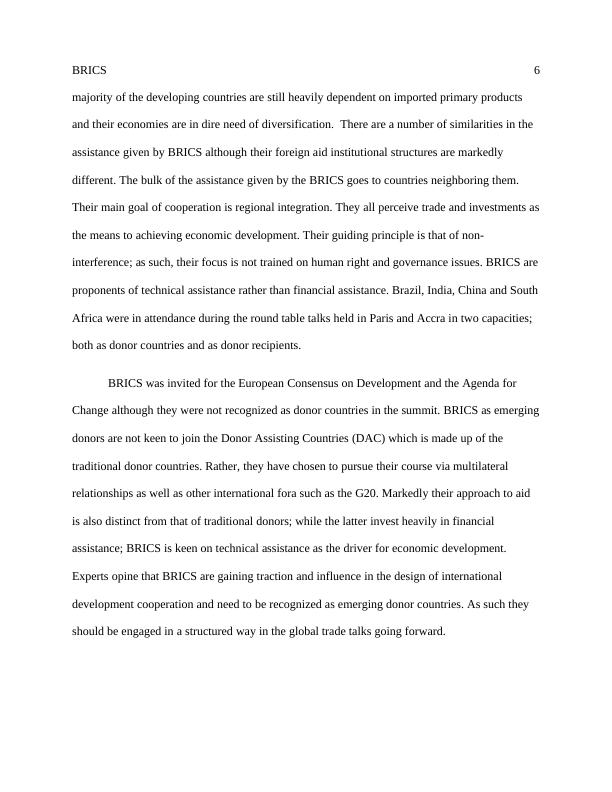
End of preview
Want to access all the pages? Upload your documents or become a member.
Related Documents
BRICS: Achievements and Failureslg...
|6
|1538
|365
International Political Economy (pdf)lg...
|24
|7853
|15
Political Economy of development PDFlg...
|17
|3859
|21
International Political Economy | BRICSlg...
|19
|6027
|22
Analyze Global Trade Environment (pdf)lg...
|12
|2830
|186
Formation of an International Alliance - BRICSlg...
|5
|921
|454
